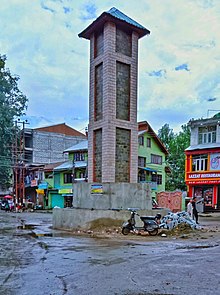
Anantnag district is an administrative district of Indian-administered Jammu and Kashmir in the disputed Kashmir region. It is one of ten districts which make up the Kashmir Valley. The district headquarters is Anantnag city. As of 2011, it was the third most populous district of Jammu and Kashmir, after Jammu and Srinagar.

Baramulla district or Varmul is one of the 20 districts in the Indian-administered union territory of Jammu and Kashmir in the disputed Kashmir region. Baramulla town is the administrative headquarters of this district. The district covered an area of 4,588 km2 (1,771 sq mi) in 2001, but it was reduced to 4,243 km2 (1,638 sq mi) at the time of 2011 census. In 2016, the district administration said that the area was 4,190 km2 (1,620 sq mi). Muslims constitute about 98% of the population.
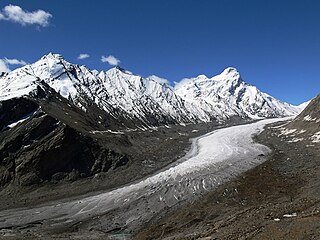
The Drang-Drung Glacier is a mountain glacier near the Pensi La pass on the Kargil-Zanskar Road in the Kargil district of Ladakh in India.

Ganderbal is a town and a municipality committee in Ganderbal District in the Indian union territory of Jammu and Kashmir. It is the headquarters of Ganderbal district. It is in Central Kashmir; it has an average elevation of 1,619 metres. It is bordered by district Srinagar District in the south, Bandipora District to the north, Kargil in the northeast, Anantnag District to the southeast, and Baramulla District in the southwest. The current District Magistrate of Ganderbal is Mr. Shyambir Singh (IAS). Ganderbal is renowned for its beauty, boasting numerous picturesque places and captivating landscapes. Sonamarg is the most famous place in Ganderbal; Shri Amarnath Ji Yatra is also traversed through Ganderbal district.

Sonamarg or Sonmarg, known as Sonamarag in Kashmiri, is a hill station located in the Ganderbal District of Jammu and Kashmir, India. It is located about 62 kilometers from Ganderbal Town and 80 kilometres (50 mi) northeast of the capital city, Srinagar.

Jammu and Kashmir is home to several valleys such as the Kashmir Valley, Chenab Valley, Sindh Valley and Lidder Valley. Some major tourist attractions in Jammu and Kashmir are Srinagar, with its renowned Dal Lake and Mughal Gardens, Gulmarg, Pahalgam, Bhaderwah, Patnitop and Jammu. Every year, thousands of Hindu pilgrims visit holy shrines of Vaishno Devi and Amarnath which has had a significant impact on the state's economy.
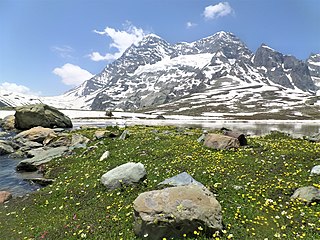
Mt Harmukh is a mountain with a peak elevation of 5,142 metres (16,870 ft), in Ganderbal district of Jammu and Kashmir in India. Harmukh is part of the Himalayas Range and is located between Sind River in the south and Kishanganga River in the north, rising above Gangabal Lake in the vicinity of Kashmir valley. It is mostly climbed from the northwestern side of Arin, via Kudara, Bandipore. Harmukh is considered sacred in Hinduism.

Bandipore district is an administrative district of Indian-administered Jammu and Kashmir in the disputed Kashmir region. It is one of the 20 districts in the Jammu and Kashmir. Bandipore town is the administrative headquarters of the district. Bandipore is located in the foothills of the snow-clad peaks of Harmukh overlooking the shores of Wular Lake and has produced hundreds of scholars and intellectuals. The district is known for its tourist places such as Wular Vintage Park, Athwatoo and Gurez valley. Before 1947, this town was a big trade and literary centre of Kashmir. This district was carved out from the erstwhile Baramulla district in 2007. The district is bounded by Kupwara district from the north, Baramulla district from west and Kargil district in Ladakh and Ganderbal district from the east. This district occupies an area of 398 km2. The district has a population of 392,232 as per 2011 census.
Kangan is a town located near Ganderbal, in the Ganderbal district of Jammu and Kashmir, India. It is one of the tehsils in District Ganderbal. It is situated across the Nallah Sindh and spread over a 50-km-long gorge valley, with population of 120,934 and literacy rate of 52.8% and sex ratio 868 per thousand males. Widely regarded for its beauty, it is surrounded by various picnic spots like Sonamarg and Naranag.
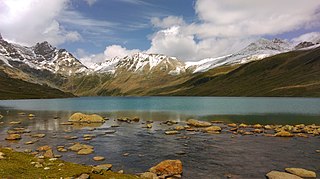
The Gangabal Lake, also called Haramukh Ganga, is an alpine high-altitude oligotrophic lake situated at the foot of Mount Haramukh in the Ganderbal district of Jammu and Kashmir, India. The lake has a maximum length of 2.5 kilometres (1.6 mi) and maximum width of 1 kilometre (0.62 mi). It is fed by precipitation, glaciers and springs and is home to many species of fish, including the brown trout. Water from the lake outflows into the nearby Nundkol Lake and then into the Sind River via Wangath Nallah. This lake is considered sacred in Hinduism as one of the abodes of Shiva, and Kashmiri Hindus perform an annual pilgrimage to the lake called Harmukh-Gangabal Yatra.

The Sind River or the Sindh River is a river in the Ganderbal district of the union territory of Jammu and Kashmir, India. It is a major tributary of the Jhelum River and is 108 km (67 mi) long.

The Gadsar Lake, also called Yemsar, is an alpine high altitude oligotrophic lake in the Ganderbal district of Kashmir Division in Jammu and Kashmir, India. It has an elevation of 3,600 metres (11,800 ft), a maximum length of 0.85 km and maximum width of 0.76 km.
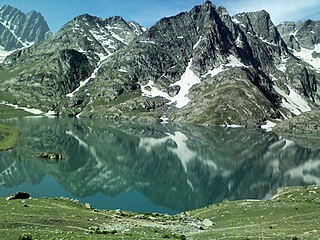
The Krishansar Lake is an alpine high elevation oligotrophic lake situated near Sonamarg, in the Ganderbal district of Jammu and Kashmir in India at an elevation of 3,710 metres (12,170 ft). It is located less than one kilometer northwest of Vishansar Lake, and has a maximum length of 0.95 km and maximum width of 0.6 km.

The Kashmir division is a revenue and administrative division of the Indian-administered Jammu and Kashmir in the disputed Kashmir region. It comprises the Kashmir Valley, bordering the Jammu Division to the south and Ladakh to the east. The Line of Control forms its boundary with the Pakistani-administered territories of Gilgit−Baltistan and Azad Jammu and Kashmir to the north and west and west, respectively.

Naranag or (Nara Nag) is a tourist village and ancient Hindu pilgrimage site, near Ganderbal town in the Ganderbal district of the Kashmir Valley in Jammu and Kashmir, India. Well known for its ancient but pillaged temple ruins complex, it is located around 8 km from Kangan, 6 km upstream from the Sind River. Noted for its scenic meadows, lakes and mountains, it is a base camp for trekking to the Mount Haramukh 16,870 ft and Gangabal Lake. The village lies at the left bank of the Wangath river, which is a tributary of the Sind River. Tourism hut at Naranag for any information and assistance tourism officials are available and hut is also provide for accommodation.
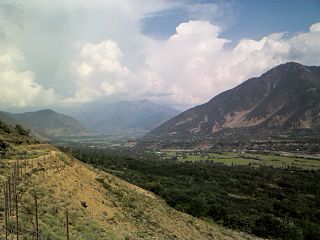
The Sind Valley is a Himalayan sub-valley of the Kashmir Valley in the Indian union territory of Jammu and Kashmir. The entrance of the Sind Valley lies 33 kilometres (21 mi) northeast of Srinagar the capital of Jammu and Kashmir. It is a 65 kilometres (40 mi) long gorge valley with an average width of 1 kilometre (0.62 mi).

The Nundkol Lake or Nund Kol also known as Nandi Kund and Kalodaka Lake is an oligotrophic alpine lake situated in Ganderbal district of the Kashmir Valley in Jammu and Kashmir, India. This lake is considered sacred by Hindus.
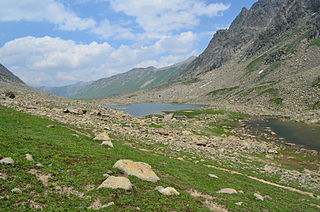
The Satsar Lake or Sat Sar consists of seven small alpine lakes situated in Ganderbal district of the Kashmir Valley in Jammu and Kashmir, India.
Beehama is a village located in the central area of district Ganderbal, Jammu and Kashmir. It is situated 18 km (11 mi) from Srinagar. The route of Beehama leads towards Kheer Bhawani, Manasbal, Sonamarg, Gadsar, Harmukh Mountain and Gangbal.
Sherpathri or Shairpathri(شیر پتھری) is one of the Blocks in District Ganderbal, Jammu and Kashmir, India. It was formed in 2014 by the J&K Govt and is located at a distance of 5 km from the main town. There are total of 7 Blocks in Ganderbal District. Sherpathri Consists of 5 Halqas viz; Gogjigund, Sehpora, Rabitar, Shallabugh and Hakim Gund. Mr. Rafeeq Ahmad Wani is currently the Naib Tehsildar Sherpathri.



